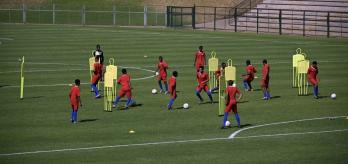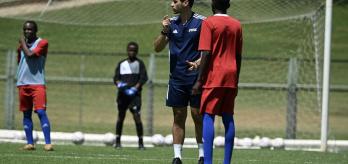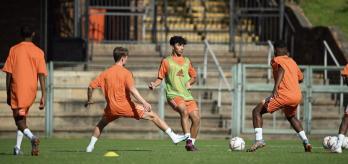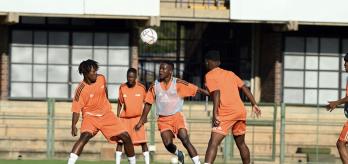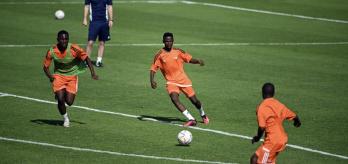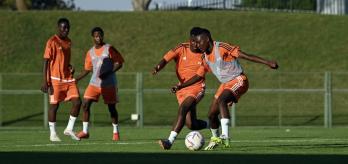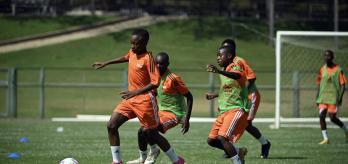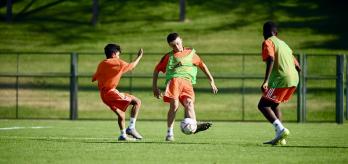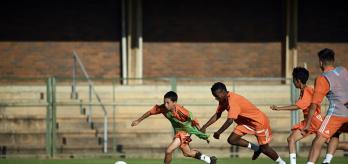Methodology
The intention: What is practised?
The objective of the exercise is to enhance a team’s ability to effectively build and progress play within a narrow focus. There are other aspects, such as creating and finishing, that do not feature in the exercise. The drill focuses on team actions, with a particular emphasis on team structure when playing out from the back and when pressing high up. During the build-up phase, the attacking team are tasked with organising themselves in the most optimal way to play through a high press, which typically involves giving the goalkeeper two passing options. The midfield aim to set up in a way that creates numerical superiority in the middle zone, while being challenged to identify moments to play forwards using quick combinations and disguised passes.
The scale: For whom is this relevant?
This possession-based drill revolves around the team, with a particular focus on the team’s structure and organisation when building up play. The exercise allows the team to work on progressing the ball through the thirds within a specific structure comprising three lines. The first line consists of two centre-backs, who typically split to offer the goalkeeper passing options, while a midfielder can drop in to offer to receive. The midfielders and full-backs work to create numerical advantages and play the ball forwards along the midfield line, whilst the centre-forward stays in the forward line and is typically supported by one or two other players. Meanwhile, the defensive structure should involve a high press, with two attackers pressing from the front, three midfielders ready to compete for possession in the middle third and two defenders waiting on the defensive line in readiness to step up.
The practice type: How is the practice designed?
The drill involves an opposed possession game, featuring variable repetition that provides ample opportunities for the team to practise offering to receive, the movement to receive, and passing and receiving within a structure. Variations develop to showcase different options when progressing play through the thirds against a high press. The reduced size of the exercise area serves to put in-possession players under time pressure, which forces the team to play at high tempo and organise themselves quickly. Three zones are marked out to help the players organise their defensive and attacking structure, while the requirements regarding the number of players in each zone, along with the neutral player’s support for the in-possession team, help to create an overload in midfield. A variation is introduced that encourages players to be assertive, with a team awarded two points when a defender steps out with the ball. The exercise is position-specific, with players operating within their zones.
Session plan
Organisation
-
Mark out a 45x20m exercise area.
-
Divide the exercise area into thirds.
-
Place a goalkeeper at either end of the exercise area.
-
Set up a 7v7 plus a joker inside the exercise area, with the attacking team arranged in a 2-4-1 formation and the defending team organised in a 2-3-2 system.
Explanation
-
The exercise begins with one of the goalkeepers in possession.
-
The goalkeeper plays the ball to an orange player.
-
The orange team’s objective is to progress play through the thirds and to connect with the goalkeeper at the opposite end of the exercise area. They are awarded a point if they manage to do so.
-
The blues aim to dispossess the orange team. If they manage to do so, the teams swap roles, with the blues becoming the in-possession team.
-
The blues must have a minimum of 2 players in each third.
-
The oranges must have at least 1 player in each third.
-
The neutral player plays with the oranges and operates in the middle third.
-
Orange players positioned in the middle third can drop into the defensive third to receive the ball and help to progress play out from the back.
Variation 1
-
One defender in each zone can move between zones to apply pressure on the back of the attacker as the ball travels towards them.
Variation 2
-
Two points are awarded if a defender carries the ball from the defensive third into the middle third and their team connect with a goalkeeper positioned at the end of the exercise area.
-
Increase the width of the exercise area by 5m on each side.
Key coaching points
Roles of coaches
-
First coach: leads the exercise and stops play at intervals to give players tips about how to receive or progress the ball more efficiently.
-
Second coach: offers the players encouragement and tips from their position on the opposite side of the exercise area to the first coach.
-
Third coach: serves balls into the exercise area to aid the fluency of the exercise.


























